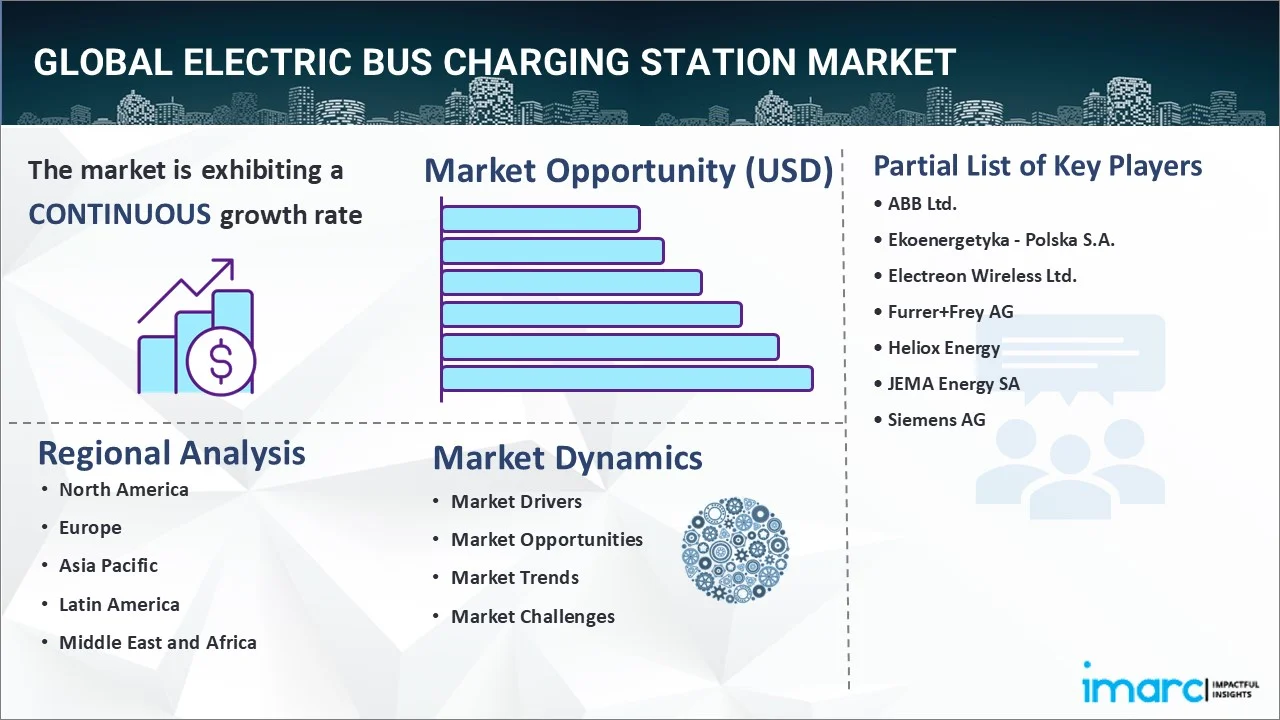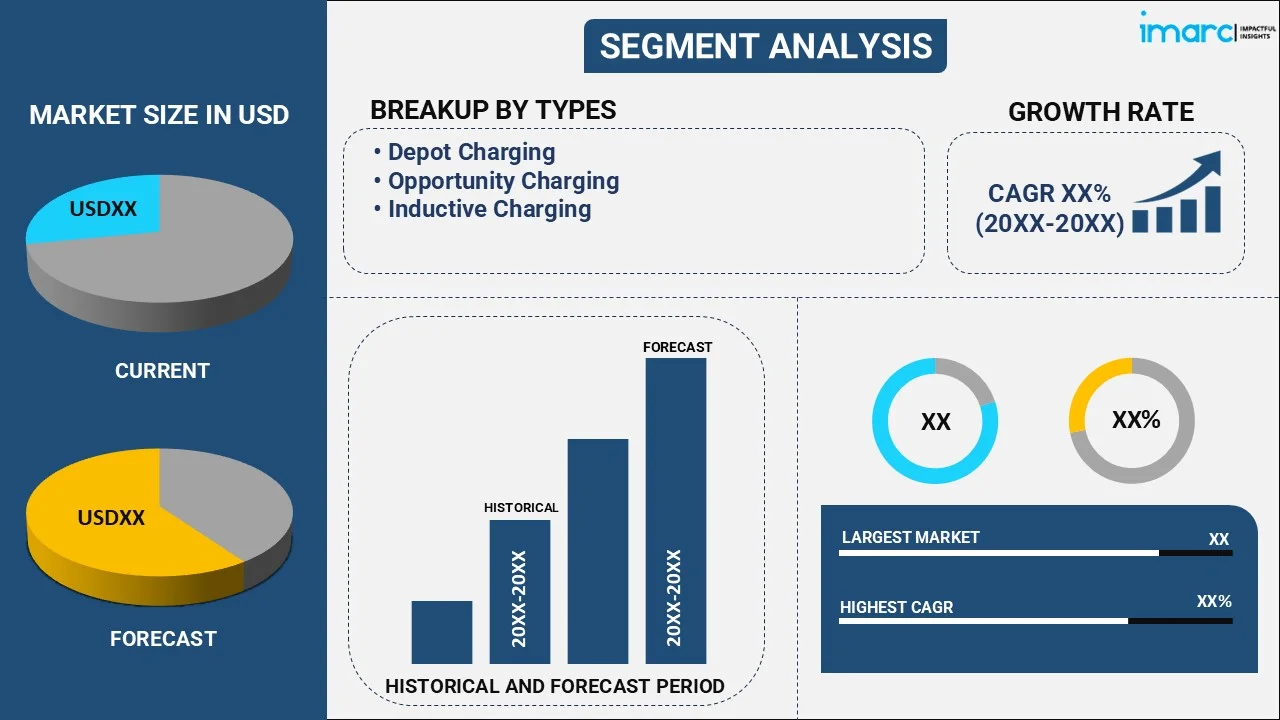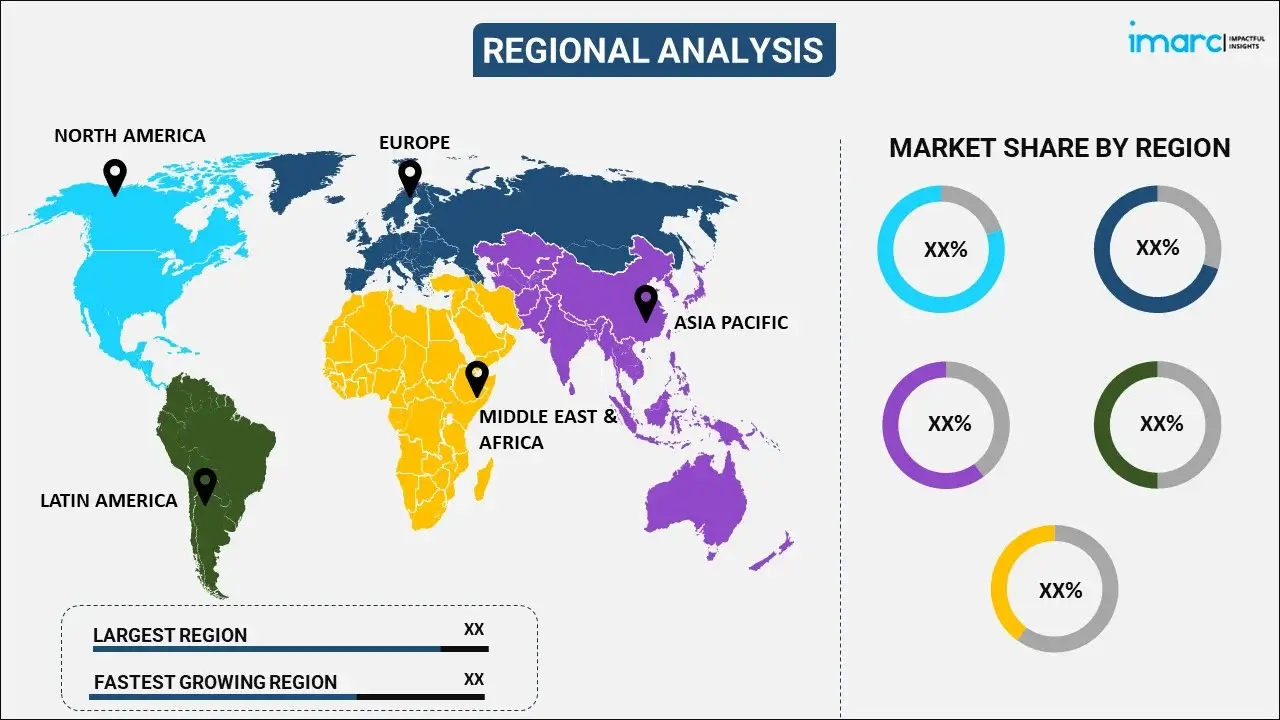
Electric Bus Charging Station Market Report by Type (Depot Charging, Opportunity Charging, Inductive Charging), Charger (Off-Board, Onboard), Power (Less than 50 Kw, 50–150 kW, 151–450 kW, More than 450 kW), and Region 2025-2033
Electric Bus Charging Station Market:
The global electric bus charging station market size reached USD 1,587.0 Million in 2024. Looking forward, IMARC Group expects the market to reach USD 20,962.0 Million by 2033, exhibiting a growth rate (CAGR) of 33.2% during 2025-2033. The market is primarily driven by the ongoing technological advancements, the rising adoption of electric buses, the escalating environmental awareness, and the launch of favorable policies and initiatives by government bodies.
|
Report Attribute
|
Key Statistics
|
|---|---|
|
Base Year
|
2024 |
|
Forecast Years
|
2025-2033
|
|
Historical Years
|
2019-2024
|
| Market Size in 2024 | USD 1,587.0 Million |
| Market Forecast in 2033 | USD 20,962.0 Million |
| Market Growth Rate (2025-2033) | 33.2% |
Electric Bus Charging Station Market Analysis:
- Major Market Drivers: The launch of favorable initiatives by government bodies, such as tax incentives, subsidies, and mandates towards clean transportation is catalyzing the electric bus charging station market growth. Besides this, the ongoing advancements in charging infrastructure, battery technology, and vehicle-to-grid (V2G) integration are further stimulating the electric bus charging station market statistics.
- Key Market Trends: The growing popularity of smart charging solutions for reducing operating costs, improving energy efficiency, and minimizing the strain on electrical grids is propelling the electric bus charging station market demand. Moreover, the emerging trend of wireless charging technology that eliminates the requirement for physical connection between the charger and the bus and enhances the aesthetic appeal is also bolstering the electric bus charging station market trends.
- Competitive Landscape: Some of the major market players in the electric bus charging station market share include ABB Ltd., Ekoenergetyka – Polska S.A., Electreon Wireless Ltd., Furrer+Frey AG, Heliox Energy, JEMA Energy SA, Siemens AG, among many others.
- Geographical Trends: Asia Pacific accounted for the largest share in the electric bus charging station market analysis, owing to its increasing population. In addition to this, the emerging trend of urbanization, the rising individual concerns towards air pollution, and the inflating investments by the leading players in charging infrastructures are also propelling the electric bus charging station market outlook in Asia Pacific.
- Challenges and Opportunities: One of the major challenges of the electric bus charging station market includes the rising strain on existing electrical grids and the high downtime for charging, impacting operational schedules. However, the improved air quality and reduced greenhouse gas emissions in urban areas and the widespread adoption of smart grids and wireless charging technology present significant growth opportunities for the electric bus charging station market revenue.

Electric Bus Charging Station Market Trends:
The Increasing Adoption of Electric Buses
The increasing consumer concerns towards air pollution and climate change are bolstering the extensive adoption of electric buses, which are primarily driving the electric bus charging station market statistics. For instance, according to electric bus manufacturers, electric buses save US$ 400,000 in fuel expenses and nearly US$ 125,000 in maintenance costs, more than making up for the higher upfront cost. Moreover, the elevating requirement for electric buses, especially in urban areas, owing to their various environmental benefits, including lower greenhouse gas (GHG) output, zero tailpipe emissions, and quieter operation, is also stimulating the market growth. In addition to this, according to the forecasts by Bloomberg New Energy Finance, by 2030, ~28% of car sales are likely to be electric vehicles, while 84% of new buses will be electric buses. Furthermore, the Joe Biden administration has proposed a US$174 Billion program to promote the adoption of electric vehicles with the goal of moving the United States toward zero-emission transportation. Besides this, China's move toward electric vehicles is expected to continue, with 420,000 new electric buses expected to be purchased by 2025. Electric bus fleets should be able to expand significantly (about 40%) as a result of market growth and government support.
The Implementation of Several Government Initiatives
The launch of favorable policies and initiatives by government bodies, such as subsidies, grants, and tax credits, across countries to promote the adoption of electric vehicles and buses in transportation to minimize carbon emissions is stimulating the electric bus charging station market growth. Moreover, the rising electrification of public transportation fleets is also catalyzing the global market. For example, the Mexican government has invested US$ 38 Million in the development of charging infrastructures in the country. Besides this, the Canadian Transport Ministry announced new purchase incentives for medium and heavy-duty zero-emission vehicles to enhance electric commercial vehicle sales across the country. The new purchase incentive is worth approximately 50% of the price difference between an electric and a traditional vehicle. Additionally, in Europe, the C40 Declaration for fossil-free streets has been signed simultaneously by 40 cities, including Paris, Berlin, London, Copenhagen, Barcelona, Rome, and Rotterdam, with the goal of zero-emission bus fleets by 2025.
Emerging Technological Advancements
The growing popularity of innovative charging solutions, on account of the rising need for more efficient and cleaner public transportation, is positively influencing the market growth. In addition to this, the introduction of fast-charging technology that improves operational efficiency, reduces charging time, and enhances the efficacy of electric bus fleets is also propelling the electric bus charging station market analysis. For instance, following a grant from the California Energy Commission, Proterra announced that the Santa Clara Valley Transportation Authority (VTA) will install an innovative clean energy microgrid and EV fleet charging system with Proterra and Scale Microgrid Solutions to power the organization's transition to a 100% zero-emission bus fleet. Moreover, the California Energy Commission has given the Los Angeles Department of Transportation (LADOT) a US$ 6 Million grant to install one of the largest EV fleet charging systems in the United States that will be powered by a solar and storage microgrid. At the Washington Bus Yard, LADOT will install a 4.5MWh Apparent energy storage system in conjunction with 1.5 megawatts of rooftop and bus solar canopy to power five Proterra 1.5 megawatt fleet chargers with 104 remote EV charging dispensers. Additionally, Siemens and MAHLE Group joined forces to collaborate on cutting-edge wireless charging systems for electric vehicles. In this collaborative effort, both companies worked together to develop and test comprehensive infrastructure and automotive engineering systems.
Electric Bus Charging Station Market Segmentation:
IMARC Group provides an analysis of the key trends in each segment of the market, along with forecasts at the global, regional and country levels for 2025-2033. Our report has categorized the market based on type, charger, and power.
Breakup by Type:

- Depot Charging
- Opportunity Charging
- Inductive Charging
Depot charging dominates the market
The report has provided a detailed breakup and analysis of the market based on the type. This includes depot charging, opportunity charging, and inductive charging. According to the report, depot charging represented the largest segment.
The growing popularity of depot charging for charging electric buses parked at bus terminals or depots or during scheduled breaks throughout the day is positively influencing the market growth. For instance, the New York Power Authority (NYPA) announced the completion of a US$ 30 Million agreement to install 67 pantograph chargers across various stations in the city to charge the city's electric bus fleet. Moreover, the Montgomery County Public School system in Maryland approved a contract with Highland Electric Transportation to convert its school bus fleet to a fully electric fleet, beginning with converting 326 school buses through 2025. Based on the contract, Highland Electric Transportation and its partners, Thomas Built Buses, Proterra, and American Bus, will electrify all five bus depots belonging to the Montgomery County Public School district and supply electric buses and charging infrastructure.
Breakup by Charger:
- Off-Board
- Onboard
Onboard holds the largest share of the market
The report has provided a detailed breakup and analysis of the market based on the charger. This includes off-board and onboard. According to the report, onboard represented the largest market segment.
Onboard charging involves the integration of the charging system directly into the electric bus. This type of charging is adequate for buses operation on shorter routes and slower charging needs.
Breakup by Power:
- Less than 50 kW
- 50–150 kW
- 151–450 kW
- More than 450 kW
Less than 50 kW accounts for the largest market share
The report has provided a detailed breakup and analysis of the market based on the power. This includes less than 50 kw, 50–150 kw, 151–450 kw, more than 450 kw. According to the report, less than 50 kW accounted for the largest segment.
The escalating demand for less than 50 kW charging stations that are cost-effective and suitable for smaller bus fleets with longer charging needs in terminals, depots, or low-traffic routes, is propelling the market growth. For instance, Metroline, a potential London bus operator, announced the purchase of 39 electric double-decker buses for intercity transit. Wrightbius, a Northern Irish bus manufacturer, procured these buses. These 39 buses are anticipated to travel through the London boroughs of Brent, Ealing, Harrow, and Barnet, as well as Watford in Hertfordshire, north of London, on the 297 and 142 routes. The buses have charging capabilities of up to 300 kW via CCS or 420 kW via pantographs.
Breakup by Region:

- North America
- United States
- Canada
- Europe
- Germany
- France
- United Kingdom
- Italy
- Spain
- Others
- Asia Pacific
- China
- Japan
- India
- South Korea
- Australia
- Indonesia
- Others
- Latin America
- Brazil
- Mexico
- Others
- Middle East and Africa
Asia Pacific exhibits a clear dominance in the market
The report has also provided a comprehensive analysis of all the major regional markets, which include North America (the United States and Canada); Asia Pacific (China, Japan, India, South Korea, Australia, Indonesia, and others); Europe (Germany, France, the United Kingdom, Italy, Spain, Russia, and others); Latin America (Brazil, Mexico, and others); and the Middle East and Africa. According to the report, Asia Pacific accounted for the largest market share, owing to the emerging trend of urbanization and the growing population. Moreover, the inflating investments by the major players in electric buses and charging stations are also propelling the market growth in this region. For instance, more than 421,000 electric buses were in use in China, which amounts to about 99.0% of the global fleet. Additionally, Shenzhen and Guangzhou are the leading cities in fully electric bus fleets, while more Chinese cities are expected to follow the same in the coming years. China is anticipated to witness growth in the adoption of electric buses, as more than 30 Chinese cities have made plans to achieve 100% electrified public transit, including Guangzhou, Zhuhai, Dongguan, Foshan, and Zhongshan in the Pearl River Delta, along with Nanjing, Hangzhou, Shaanxi, and Shandong. Furthermore, in India, on behalf of the five state governments, CESL-Convergence Energy Services Ltd. (a subsidiary of EESL-Energy Efficiency Services Ltd.) granted a contract for 5,450 electric buses. CESL plans to conduct a $10 Billion (Rs.80,000 Crore) tender for 50,000 electric buses, which has been authorized by NITI Ayog to reduce pollution in India and boost E-Bus manufacturers.
Competitive Landscape:
Companies in the market are actively engaged in several key activities to meet the growing demand for charging infrastructure and drive the adoption of electric buses. They are expanding their presence in different regions to cater to the increasing demand for electric bus charging infrastructure worldwide. They are establishing partnerships, collaborations, and joint ventures with local players to strengthen their market position. Many companies are investing in research and development (R&D) activities to improve charging efficiency, reduce environmental impacts, and enhance overall sustainability. They are also exploring alternative materials and energy-efficient technologies for their charging stations. Besides this, charging station manufacturers are continuously developing and innovating their products to provide more efficient, faster, and user-friendly charging solutions including advancements in fast-charging technology, wireless charging systems, and smart grid integration.
The market research report has also provided a comprehensive analysis of the competitive landscape in the market. Competitive analysis such as market structure, key player positioning, top winning strategies, competitive dashboard, and company evaluation quadrant has been covered in the report. Also, detailed profiles of all major companies have been provided. Some of the major market players in the Electric Bus Charging Station industry include:
- ABB Ltd.
- Ekoenergetyka – Polska S.A.
- Electreon Wireless Ltd.
- Furrer+Frey AG
- Heliox Energy
- JEMA Energy SA
- Siemens AG
(Please note that this is only a partial list of the key players, and the complete list is provided in the report.)
Electric Bus Charging Station Market News:
- March 2024: Italy's first electric bus depot equipped with hardware from Finnish manufacturer Kempower has gone into operation in Bologna. The public transport operator TPER (Transporto Passeggeri Emilia-Romagna) utilizes DC technology from Kempower to charge 20 electric buses simultaneously.
- January 2024: The Delhi Transport Corporation (DTC) planned to upgrade three bus depots and install charging infrastructure for electric buses by the end of April. The depots in Ghazipur, East Vinod Nagar, and Shadipur currently only accommodate CNG buses. The upgrade will allow the depots to accommodate 120 electric buses. Delhi currently has 1,300 electric buses in operation and plans to add 1,480 more by March. The transport minister aims to have a total of 8,000 electric buses in Delhi by 2025.
- October 2023: The pilot of the flash-charging technology developed by Hitachi Energy India with Ashok Leyland and IIT Madras is getting ready for unfolding. At the inauguration of Hitachi Energy’s Global Technology and Innovation Centre in Chennai on October 5, 2023, N Venu, Managing Director and CEO – India and South Asia, Hitachi Energy, said that the group’s flash charging technology will happen soon at IIT Madras with bus provided by Ashok Leyland.
Electric Bus Charging Station Market Report Scope:
| Report Features | Details |
|---|---|
| Base Year of the Analysis | 2024 |
| Historical Period | 2019-2024 |
| Forecast Period | 2025-2033 |
| Units | Million USD |
| Scope of the Report | Exploration of Historical Trends and Market Outlook, Industry Catalysts and Challenges, Segment-Wise Historical and Future Market Assessment:
|
| Types Covered | Depot Charging, Opportunity Charging, Inductive Charging |
| Chargers Covered | Off-Board, Onboard |
| Powers Covered | Less than 50 Kw, 50–150 kW, 151–450 kW, More than 450 kW |
| Regions Covered | Asia Pacific, Europe, North America, Latin America, Middle East and Africa |
| Countries Covered | United States, Canada, Germany, France, United Kingdom, Italy, Spain, China, Japan, India, South Korea, Australia, Indonesia, Brazil, Mexico |
| Companies Covered | ABB Ltd., Ekoenergetyka - Polska S.A., Electreon Wireless Ltd., Furrer+Frey AG, Heliox Energy, JEMA Energy SA, Siemens AG, etc. |
| Customization Scope | 10% Free Customization |
| Post-Sale Analyst Support | 10-12 Weeks |
| Delivery Format | PDF and Excel through Email (We can also provide the editable version of the report in PPT/Word format on special request) |
Key Questions Answered in This Report:
- How has the global electric bus charging station market performed so far, and how will it perform in the coming years?
- What are the drivers, restraints, and opportunities in the global electric bus charging station market?
- What is the impact of each driver, restraint, and opportunity on the global electric bus charging station market?
- What are the key regional markets?
- Which countries represent the most attractive electric bus charging station market?
- What is the breakup of the market based on the type?
- Which is the most attractive type in the electric bus charging station market?
- What is the breakup of the market based on the charger?
- Which is the most attractive charger in the electric bus charging station market?
- What is the breakup of the market based on power?
- Which is the most attractive power in the electric bus charging station market?
- What is the competitive structure of the global electric bus charging station market?
- Who are the key players/companies in the global electric bus charging station market?
Key Benefits for Stakeholders:
- IMARC’s report offers a comprehensive quantitative analysis of various market segments, historical and current market trends, market forecasts, and dynamics of the global electric bus charging station market from 2019-2033.
- The research study provides the latest information on the market drivers, challenges, and opportunities in the global electric bus charging station market.
- The study maps the leading, as well as the fastest-growing, regional markets. It further enables stakeholders to identify the key country-level markets within each region.
- Porter's five forces analysis assist stakeholders in assessing the impact of new entrants, competitive rivalry, supplier power, buyer power, and the threat of substitution. It helps stakeholders to analyze the level of competition within the electric bus charging station industry and its attractiveness.
- Competitive landscape allows stakeholders to understand their competitive environment and provides an insight into the current positions of key players in the market.
Need more help?
- Speak to our experienced analysts for insights on the current market scenarios.
- Include additional segments and countries to customize the report as per your requirement.
- Gain an unparalleled competitive advantage in your domain by understanding how to utilize the report and positively impacting your operations and revenue.
- For further assistance, please connect with our analysts.
 Request Customization
Request Customization
 Speak to an Analyst
Speak to an Analyst
 Request Brochure
Request Brochure
 Inquire Before Buying
Inquire Before Buying




.webp)




.webp)












